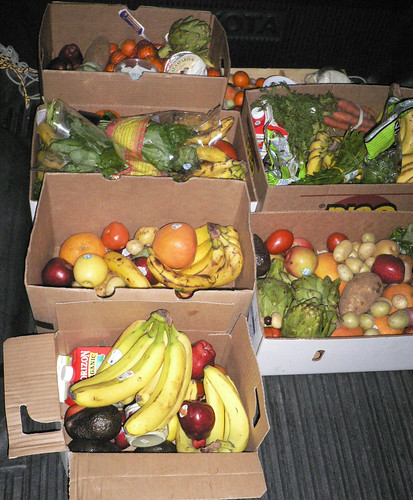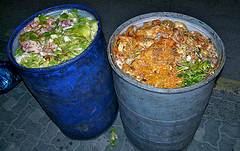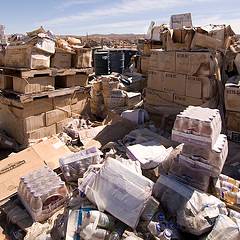 根據聯合國農糧組織(FAO)所委託的一份新研究報告指出,供人類食用的產品中,有1/3遭到浪費或損壞,總量高達每年13億公噸之多。
根據聯合國農糧組織(FAO)所委託的一份新研究報告指出,供人類食用的產品中,有1/3遭到浪費或損壞,總量高達每年13億公噸之多。
研究人員發現,富裕國家的消費者每年浪費掉的食物約有2.22億公噸,幾乎等於整個南非洲地區(sub-Saharan Africa)的總產量。其中又以蔬菜、水果以及根莖類食物為大宗。
根據FAO在2010年的統計,在這段期間有9.25億人正處於飢餓之中,而每年1090萬名死亡的兒童中,有一半導因於營養不良。
在這份報告中,FAO委託了瑞典食品與生物技術研究所進行了兩項研究,分別對中高收入國家以及低收入國家中,食物損失與浪費的原因與預防所產生的範圍與效果進行研究。
這份報告是為了2011年5月16至17日在德國杜塞爾多夫(Dusseldorf)所舉辦的國際食品包裝工業貿易展中《節約食物!》國際研討會所準備。
《節約食物!》旨在提高公眾對全球糧食損失和浪費的關注,以及這些現象對全球的貧窮與飢餓問題的影響,也包含氣候變遷與自然資源利用等議題。
報告中對於糧食損失與食物浪費做出了不同的定義。
 糧食損失最常發生在發展中國家,導因於基礎設施差、技術水平低落以及對食品生產系統的投資較低。
糧食損失最常發生在發展中國家,導因於基礎設施差、技術水平低落以及對食品生產系統的投資較低。
舉例來說,巴基斯坦的中央批發市場拉合爾(Lahore),香蕉的交易環境十分不衛生,食品在靠近排水溝的地面堆放、處理,因而對健康造成危害。報告中並指出,「這樣的市場環境也造成食物的浪費,因為衛生條件不佳以及粗心的裝卸使得脆弱的新鮮食品毀損。」
在開發中國家,40%的食物損失發生在採收後以及加工階段,而工業化國家中,40%的食物損失則發生在零售與消費者層級。
食物浪費問題在工業化國家中更加嚴重,主要是因為零售商與消費者把可食用的食品丟進了垃圾桶。
北美與歐洲每名消費者每年浪費掉的食物約在95-115公斤,相對地,南非洲以及南亞、東南亞等地的消費者每年約只丟棄6-11公斤的食物。
這份報告同也提供了幾項可行的方法來減少食物的損失與浪費。
報告中建議,對於發展中國家而言,可以加強食品供應鍊,幫助連結小農戶與買家。而公營或私人部門應該要對運輸、加工與包裝等基礎設施進行投資。
至於中高收入國家,糧食的損失與浪費是因為消費者的行為以及供應鍊中,不同參與者的溝通不良。
 報告指出,「富裕國家中消費者層級浪費食物的最重要原因,可能僅只是因為人們負擔得起。」
報告指出,「富裕國家中消費者層級浪費食物的最重要原因,可能僅只是因為人們負擔得起。」
報告中發現,在零售端大量的食物浪費是因為品管的過程中,過份的強調外觀。
但研究人員在報告中指出,調查顯示消費者願意購買外觀不符合標準,但安全無虞、口味良好的食品,消費者有能力影響品管的標準,而且也應該那麼做。
作者建議,農產品可以在靠近消費者的小農市集和農產品商店銷售,而不必符合超市的外觀標準。
 一般而言,富裕國家的消費者都受到鼓勵去購買多過所需的數量。「買二送一」的促銷活動就是個例子,另一個例子則是食品業生產的超大份量「即食食品」。而「吃到飽」的自助餐廳則變相鼓勵顧客堆滿他們的盤子。
一般而言,富裕國家的消費者都受到鼓勵去購買多過所需的數量。「買二送一」的促銷活動就是個例子,另一個例子則是食品業生產的超大份量「即食食品」。而「吃到飽」的自助餐廳則變相鼓勵顧客堆滿他們的盤子。
與此同時,該份報告發現富裕國家的消費著無法妥善規劃其食品購買計畫,這意味著他們經常在食物有效期限屆滿時將之丟棄。
報告建議,學校教育以及公共政策可能是改變消費者行為的出發點。「應該教育富裕國家的消費者:丟棄不必要的食物是一種不能被接受的行為。」
作者們建議,「人們還應該知道,由於自然資源有限,為了養活不斷增長的世界人口,減少糧食損耗比增產更為有效。」
One-third of the food produced for human consumption in the world each year is lost or wasted, amonting to 1.3 billion metric tonnes, according to new research commissioned by the UN Food and Agriculture Organization.
Every year, the researchers learned, consumers in rich countries waste about 222 million metric tonnes of food, almost as much as the entire net food production of sub-Saharan Africa. Fruits and vegetables, roots and tubers have the highest wastage rates of any foods.
At the same time, 925 million people are hungry, and poor nutrition plays a role in at least half of the 10.9 million child deaths each year, according to FAO estimates from 2010.
For this report, FAO hired the services of the Swedish Institute for Food and Biotechnology to carry out two studies on the extent and effects, causes and prevention of food losses and food waste - one for high and medium-income countries, and one for low-income countries.
Their report was prepared for Save Food! an international congress being held in Dusseldorf, Germany May 16-17 at the trade fair of the international packaging industry Interpack 2011.
Save Food! aims to raise public awareness of global food losses and waste, and of the impact of these on poverty and hunger in the world, as well as on climate change and on the use of natural resources.
The report distinguishes between food loss and food waste.
Food losses occur most often in developing countries, due to poor infrastructure, low levels of technology and low investment in the food production systems.
At the central wholesale market in Lahore, Pakistan, for instance, bananas are traded in unsanitary conditions, causing health hazards since food is handled and piled on the ground close to the gutter, the report states, adding, "This kind of market environment also causes food waste, since the unsanitary conditions and rough handling cause deterioration of fragile fresh products."
In developing countries 40 percent of food losses occur at post-harvest and processing levels, while in industrialized countries more than 40 percent of losses happen at retail and consumer levels.
Food waste is more a problem in industrialized countries, where it is most often caused by retailers and consumers throwing edible foodstuffs into the trash.
Per capita waste by consumers is between 95-115 kilograms (209-253 pounds) a year in Europe and North America, while consumers in sub-Saharan Africa and South and Southeast Asia each throw away only 6-11 kg (13-24 pounds) a year.
The report offers several practical suggestions on how to reduce losses and waste.
In developing countries the food supply chain could be strengthened by assisting small farmers to link directly to buyers. Both private and public sectors should also invest more in infrastructure, transportation and in processing and packaging, the report recommends.
In middle-income and high-income countries food losses and waste are due to consumer behavior and lack of communication between different actors in the supply chain.
"Perhaps one of the most important reasons for food waste at the consumption level in rich countries is that people simply can afford to waste food," the report states.
At retail level, large quantities of food are wasted due to quality standards that over-emphasize appearance, the report finds.
But the researchers point to surveys showing that consumers are willing to buy produce not meeting appearance standards as long as it is safe and tastes good. Customers have the power to influence quality standards and should do so, the report says.
Farm produce could be sold closer to consumers in farmers' markets and farm shops, without having to conform to supermarkets' appearance standards, the authors suggest.
Consumers in rich countries are generally encouraged to buy more food than they need. "Buy three, pay two" promotions are one example, while the oversized ready-to-eat meals produced by the food industry are another. Restaurants frequently offer fixed-price buffets that spur customers to heap their plates.
At the same time, consumers in rich countries fail to plan their food purchases properly, the report finds. That means they often throw food away when "best-before" dates expired.
Education in schools and political initiatives are possible starting points to changing consumer attitudes, the report suggests. "Rich-country consumers should be taught that throwing food away needlessly is unacceptable."
"They should also be made aware that given the limited availability of natural resources it is more effective to reduce food losses than increase food production in order to feed a growing world population," the authors advise.
全文及圖片詳見:ENS報導




